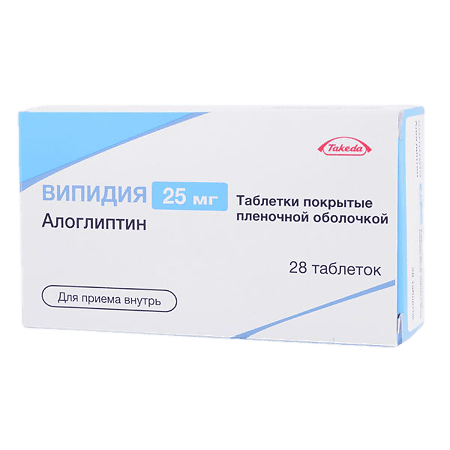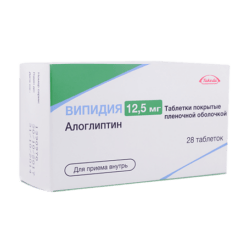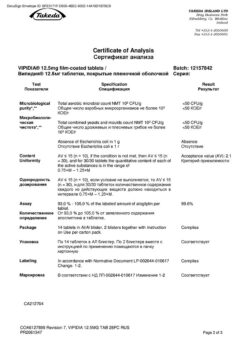No products in the cart.
Vipidia, 25 mg 28 pcs
€37.64 €31.37
Description
Type 2 diabetes
Type 2 diabetes mellitus to improve glycemic control when diet therapy and physical activity are ineffective:
in adults as monotherapy, in combination with other oral hypoglycemic agents or with insulin.
Indications
Indications
Type 2 diabetes mellitus to improve glycemic control when diet therapy and exercise are ineffective:
in adults as monotherapy, in combination with other oral hypoglycemic agents or with insulin.
Special instructions
Special instructions
Use with other hypoglycemic drugs
In order to reduce the risk of hypoglycemia, it is recommended to reduce the dose of sulfonylurea derivatives, insulin or the combination of pioglitazone (thiazolidinedione) with metformin when used simultaneously with Vipidia (see Dosage and Administration).
Unexplored combinations
The efficacy and safety of Vipidia in combination with sodium-dependent glucose cotransporter 2 inhibitors or glucagon-like peptide analogues and in triple combination with metformin and sulfonylurea derivatives have not been studied.
Kidney failure
Because patients with moderate renal failure require dose adjustment of Vipidia; it is recommended to assess renal function before starting and periodically during treatment (see Dosage and Administration).
Vipidia should not be used in patients with severe renal failure, as well as in patients with end-stage chronic renal failure requiring hemodialysis (see Dosage and Administration).
Acute pancreatitis
The use of DPP-4 inhibitors is associated with a potential risk of developing acute pancreatitis. In a pooled analysis of 13 clinical trials of alogliptin 25 mg/day, 12.5 mg/day, comparator, and placebo, the incidence of acute pancreatitis was 3, 1, 1, or 0 cases per 1000 patient-years in each group, respectively. Patients should be informed of the characteristic symptoms of acute pancreatitis: persistent severe abdominal pain that may radiate to the back. If the development of acute pancreatitis is suspected, stop taking Vipidia; If acute pancreatitis is confirmed, the drug should not be resumed. There is no data on whether there is an increased risk of developing pancreatitis while taking Vipidia in patients with a history of pancreatitis. Therefore, patients with a history of pancreatitis should be careful.
Liver failure
There have been post-marketing reports of liver dysfunction, including liver failure, with alogliptin. Their connection with the use of the drug has not been established. However, patients should be carefully examined for possible abnormalities in liver function. If abnormalities in liver function are detected and an alternative etiology for their occurrence has not been established, the possibility of discontinuing treatment with the drug should be considered.
Impact on the ability to drive vehicles and machinery
The drug Vipidia does not have or has an insignificant effect on the ability to drive vehicles and machines. However, it is necessary to take into account the risk of developing hypoglycemia when using the drug in combination with other hypoglycemic drugs (sulfonylurea derivatives, insulin or combination therapy with pioglitazone and metformin) and use caution when driving vehicles and machinery.
Active ingredient
Active ingredient
Alogliptin
Composition
Composition
1 tablet 25 mg contains
Active substance:
alogliptin benzoate – 34 mg (in terms of alogliptin -25 mg).
Excipients:
Core:
mannitol 79.7 mg,
microcrystalline cellulose 22.5 mg,
hyprolose 4.5 mg,
croscarmellose sodium 7.5 mg,
magnesium stearate 1.8 mg.
Film casing:
hypromellose 2910 5.34 mg,
titanium dioxide 0.6 mg,
iron oxide red dye 0.06 mg,
macrogol-8000 trace amounts, gray ink F1 trace amounts
Contraindications
Contraindications
hypersensitivity to alogliptin or to any excipient, or a history of serious hypersensitivity reactions to any DPP-4 inhibitor, including anaphylactic reactions, anaphylactic shock and angioedema;
type 1 diabetes mellitus;
diabetic ketoacidosis;
chronic heart failure (functional class III-IV according to the functional classification of chronic heart failure of the New York Heart Association);
severe liver failure (more than 9 points on the Child-Pugh scale) due to the lack of clinical data on use;
severe renal failure;
pregnancy, breastfeeding – due to the lack of clinical data on use;
children under 18 years of age – due to the lack of clinical data on use.
With caution
History of acute pancreatitis (see Special Instructions).
In patients with moderate renal failure (see Special Instructions).
In combination with a sulfonylurea derivative or insulin (see Special instructions).
Taking a three-component combination of the drug Vipidia with metformin and thiazolidinedione (see Special instructions).
Side Effects
Side Effects
Nervous system disorders:
Often: headache.
Gastrointestinal disorders:
Common: epigastric pain, gastroesophageal reflux disease.
Frequency not established: acute pancreatitis.
Disorders of the liver and biliary tract:
Frequency not established: liver dysfunction, including liver failure.
Disorders of the skin and subcutaneous tissues:
Common: itching, rash.
Frequency not established: exfoliative skin diseases, including Stevens-Johnson syndrome, angioedema, urticaria.
Infectious or parasitic diseases
Common: upper respiratory tract infections, nasopharyngitis.
Immune system disorders
Frequency not established: hypersensitivity reactions, including anaphylactic reaction.
Interaction
Interaction
Effect of other drugs on alogliptin
Alogliptin is mainly excreted unchanged from the body by the kidneys, and is to a small extent metabolized by the cytochrome (CYP) P450 enzyme system.
In drug interaction studies, the following drugs did not have a clinically significant effect on the pharmacokinetics of alogliptin: gemfibrozil (CYP2C8/9 inhibitor), fluconazole (CYP2C9 inhibitor), ketoconazole (CYP3A4 inhibitor), cyclosporine (p-glycoprotein inhibitor), α-glycosidase inhibitor, digoxin, metformin, cimetidine, pioglitazone or atorvastatin. Effect of alogliptin on other drugs In vitro studies have shown that alogliptin does not inhibit or induce CYP 450 isoforms at concentrations achieved when taking alogliptin at the recommended dose of 25 mg. Interactions with CYP 450 isoforms are not expected and have not been detected.
In vitro studies revealed that alogliptin is neither a substrate nor an inhibitor of OAT1, OAT3 and OCT2. In addition, clinical trial data do not indicate interactions with p-glycoprotein inhibitors or substrates.
In clinical drug interaction studies, alogliptin did not have a clinically significant effect on the pharmacokinetics of the following drugs: caffeine, (R)- and (S)-warfarin, pioglitazone, glibenclamide, tolbutamide, dextromethorphan, atorvastatin, midazolam, oral contraceptives (norethindrone and ethinyl estradiol), digoxin, fexofenadine, metformin or cimetidine. Based on these data, alogliptin does not inhibit the cytochrome isoenzymes CYP1A2, CYP3A4, CYP2D6, CYP2C9, p-glycoprotein and OCT2.
Alogliptin had no effect on the prothrombin index or International Normalized Ratio (INR) in healthy volunteers when administered concomitantly with warfarin. Taking alogliptin in combination with metformin, or pioglitazone (thiazolidinedione), or an α-glycosidase inhibitor, or glibenclamide (a sulfonylurea derivative) did not show clinically significant pharmacokinetic interactions.
Overdose
Overdose
The maximum dose of alogliptin in clinical studies was 800 mg/day in healthy volunteers and 400 mg/day in patients with type 2 diabetes mellitus for 14 days. This is 32 and 16 times, respectively, the recommended daily dose of 25 mg of alogliptin. There were no serious adverse events when taking the drug at these doses.
In case of overdose, gastric lavage and symptomatic treatment may be recommended.
Alogliptin is poorly dialyzable. In clinical studies, only 7% of the dose was removed from the body during a 3-hour dialysis session. There are no data on the effectiveness of peritoneal dialysis with alogliptin.
Storage conditions
Storage conditions
Store at a temperature not exceeding 25°C.
Shelf life
Shelf life
3 years.
Manufacturer
Manufacturer
Takeda Island Limited, Ireland
Additional information
| Shelf life | 3 years. |
|---|---|
| Conditions of storage | Store at a temperature not exceeding 25 ° C. |
| Manufacturer | Takeda Island Limited, Ireland |
| Medication form | pills |
| Brand | Takeda Island Limited |
Other forms…
Related products
Buy Vipidia, 25 mg 28 pcs with delivery to USA, UK, Europe and over 120 other countries.
















